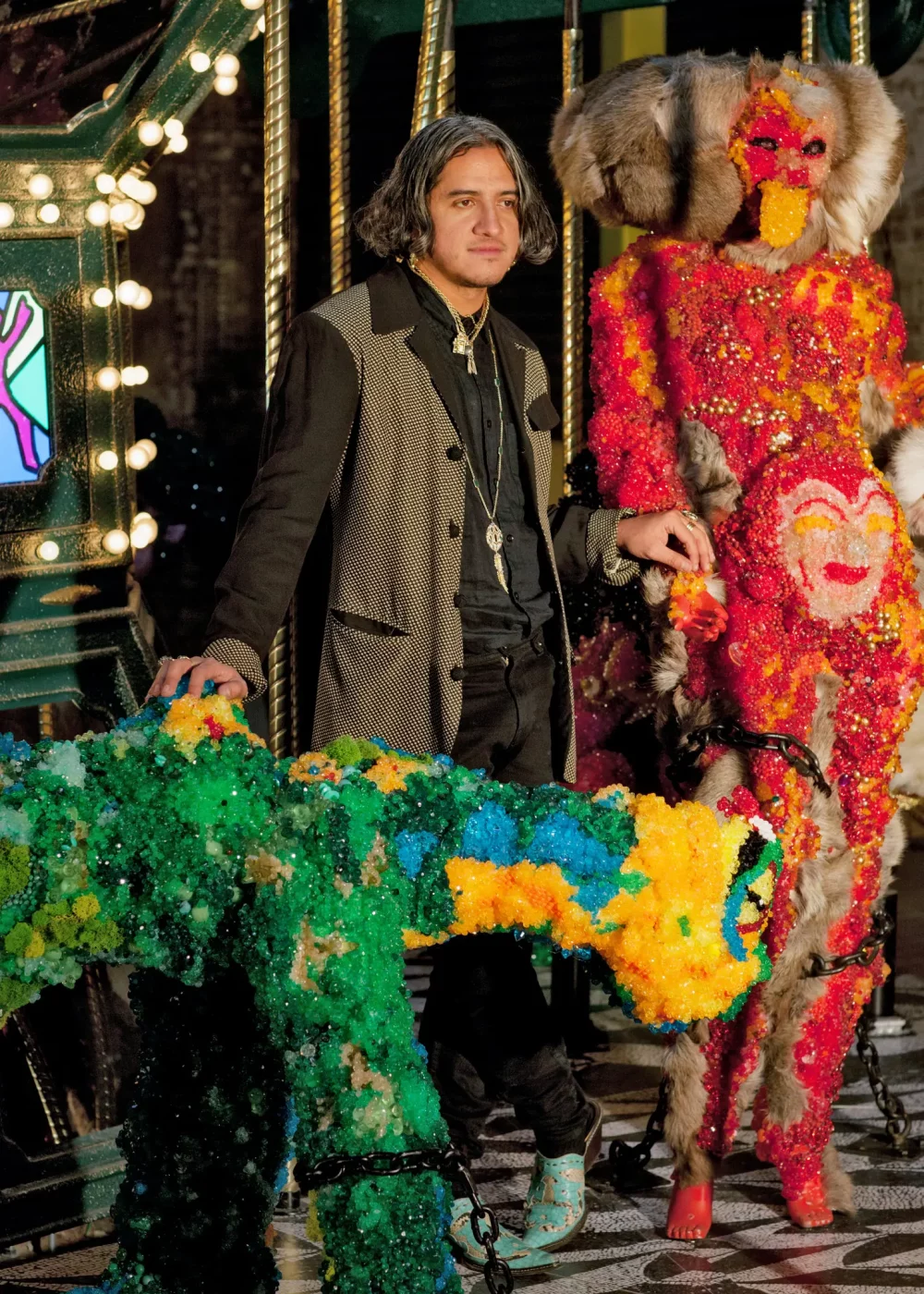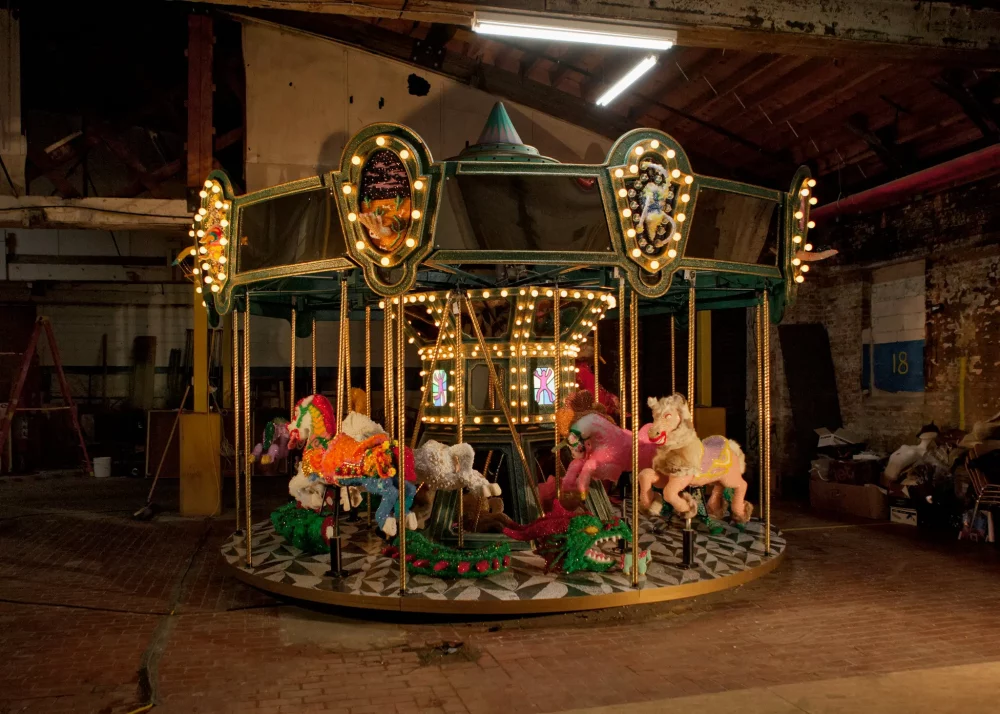
- Source: THE NEW YORK TIMES
- Author: DAVID COLMAN
- Date: DECEMBER 4, 2018
- Format: PRINT AND ONLINE
All the Pretty Horses! A Carousel at Art Basel
A jewel from the artist Raúl de Nieves, Art Production Fund and Bulgari lights up Miami Beach.

Artist Raul de Nieves
Natalia Mantini for The New York Times
With much public attention gobbled up by politically sensational works at last year’s Whitney Biennial, the art of Raúl de Nieves felt like a calming counterweight. His uplifting, beautiful panorama of 18 stained-glass-like works covering a wall of windows was an aesthetic argument for violins over violence.
But on Tuesday at the Faena Hotel in Miami during Art Basel Miami Beach, Mr. de Nieves will unveil a new work that’s more of a showstopper: a life-size, fully functioning carousel commissioned by the Art Production Fund and Bulgari. It is quite a spectacle: 16 feet wide, with circling beasts plastered and piled with glinting handfuls of the artist’s favorite glittering tiny plastic beads.
At 35, Mr. de Nieves has all the markers of young success. He has been included in prestigious group exhibitions in MoMA PS1’s Greater New York, Documenta and Performa, and in February his first solo museum show will open, at the Cleveland Museum of Art.
He does performance work in which his stalagmite-like sculptures come to alarming life, and also sings with his band, Hairbone. A pair of his beaded shoes have been photographed by Karl Lagerfeld. And the list goes on.
His glimmering dark fantasy world began fulminating in Mexico, where he was born, and continued in San Diego, where his family moved when he was 9. Mr. de Nieves fetishizes and collects vintage pieces of fastidiously microbeaded clothing made by Mexican craftswomen in his home state of Michoacán, but he is just as energized by the universe of Michael’s, the chain of craft-supply stores.
His fairy-tale visions owe much to European medieval legends (his favorite is the English tale of St. George and the Dragon) as well as to his romantic fond memories of the stories of Mexican saints, and over-the-top works by his favorite fashion designers Christian Lacroix or John Galliano.
This heady whirlwind of sources find a natural home in the carousel. The amusement park staple is today cherished as a nostalgic Victorian-era emblem of childhood and also 1950s kitsch. It was a focus for Disneyland when it opened in 1955; for the 1964 film version of “Mary Poppins,” a beloved and recently revived 1945 Rodgers and Hammerstein musical, and in an even darker vein, for Hitchcock’s “Strangers on a Train” (1951).
But though it seems as innocent as ice cream, the carousel can trace its roots back to the Middle Ages and the crusades, when knights would practice for combat in riding rings, a tradition that turned into the popular spectacle of jousting matches, or as it was later called, tilting.
In one version of the sport, horsemen would ride round a circle and try to spear their lances into a metal ring. History’s most famous tilter is also arguably Spanish literature’s most famous character, Don Quixote de la Mancha, who is one of Mr. de Nieves’s heroes.
As the centuries wore on, the circle evolved into a revolving platform, the horses evolved into horse statues and the generic metal ring became the fabled brass ring.

Light fantastic: the artwork when it was still in Brooklyn. Natalia Mantini for The New York Times
“I like the carousel as this vehicle for memories, fantasies, imagination and then ultimately reality, too — making things tangible, which can connect us to different times and experiences,” he said. “There’s this sense of something happening, all these narratives and animals and mythologies and possibilities. That’s why I proposed the idea of making a carousel, because that’s what my work is about — this idea of transforming your own personal dreams into reality.”
The artist pitched the idea of a carousel to Casey Fremont, the executive director of the Art Production Fund, in June, and she enlisted Bulgari as a partner. One might think the company’s ruby and emerald cabochons a far cry from Mr. de Nieves’s mounds of plastic microbeads, but Bulgari has played angel to many art projects over the years, and in a 2016 performance piece, “Somos Montros,” Mr. de Nieves cried out, “Diamonds! Rubies! Emeralds!”
Ms. Fremont’s team helped Mr. de Nieves locate an existing (and functioning) merry-go-round from the 1950s in Brooklyn, and he and a crew of assistants got to work, spreading his colored-caviar beads over all the horses.
He added a few new figures: a dark and disturbing mother figure in a tortured yoga-like pose, and around the merry-go-round floor the severed green glistening segments of St. George’s dragon, representing the violent and glorious circle of life.
The sculpture’s nature became clear the moment the finished product was switched on for a test run at the Faena, a vehicle that takes you right into Mr. de Nieves’s imagination. Not a time machine, but a mind machine.
“I don’t come from a place of privilege,” Mr. de Nieves said in his studio in the Bushwick section of Brooklyn before leaving for Miami. “But what I want to do is create a moment, even uplift myself.” Downstairs from a nightclub, the place was piled with works in progress, fake jewels, shoes, glue guns and colored acetate.
“It’s not that I don’t pay attention to what’s going on in the world,” he said. “But I don’t want to always be focusing on the negative, because I already know it exists.”

